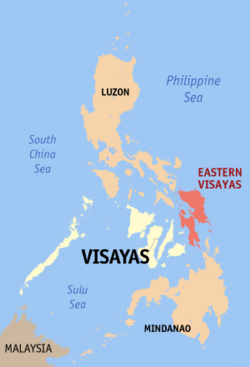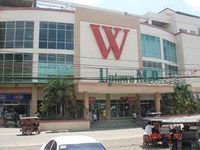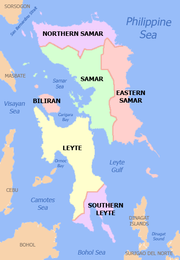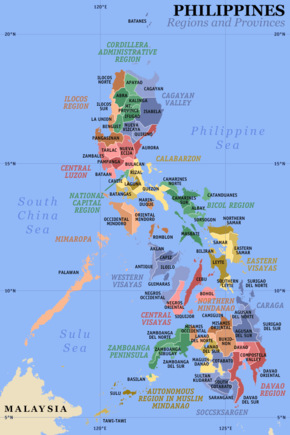Eastern Visayas
| Region VIII Eastern Visayas |
|
|---|---|
| — Region — | |
 |
|
| Country | Philippines |
| Island group | Visayas |
| Regional center | Tacloban City, Leyte |
| Area | |
| - Total | 23,432 km2 (9,047.1 sq mi) |
| Population (2007) | |
| - Total | 3,912,936 |
| - Density | 167/km2 (432.5/sq mi) |
| Time zone | PST (UTC+8) |
| Provinces | 6 |
| Cities | 7 |
| Municipalities | 136 |
| Barangays | 4,390 |
| Cong. districts | 12 |
| Languages | Waray-Waray (Leyte-Samarnon), Cebuano, Abaknon |
Eastern Visayas is one of the two regions of the Philippines having no land border with another region, MIMAROPA being the other, and is designated as Region VIII. It consists of six provinces, namely, Biliran, Eastern Samar, Leyte, Northern Samar, Samar and Southern Leyte. These provinces occupy the easternmost islands of Visayas: Leyte, Samar and Biliran. The regional center is Tacloban City.
Contents |
Geography
Climate
The region receives heavy rainfalls and typhoons throughout the year with no pronounced dry season.
Land
Eastern Visayas is primarily an agricultural region with rice, corn, coconut, sugarcane and banana as major crops. Its total land area is 21,431.7 km². 52% of its total land area are classified as forestland and 48% as alienable and disposable land.
Natural Resources
The region’s sea and inland waters are rich sources of salt and fresh water fish and other marine products. It is one of the fish exporting regions of the country. There are substantial forest reserves in the interiors of the islands. Its mineral deposits include chromite, nickel, clay, coal, limestone, pyrite and sand and gravel. It has abundant geothermal energy and water resources to support the needs of medium and heavy industries.
Culture
Region VIII is inhabited by the Waray-Waray, the country’s fourth largest cultural linguistic group. But Cebuanos, from the nearby island of Cebu live in Ormoc City, Western Leyte and parts of the southwest of Leyte.
Languages
Waray-Waray is spoken on the island of Samar, eastern Biliran and the eastern part of the province of Leyte while Cebuano is spoken in the rest of Leyte, western Biliran, as well as in the province of Southern Leyte; both of these languages are called Visayan by their speakers. A Samar language, distantly related to the languages of the region, called Abaknon is spoken in the island of Capul in Northern Samar.
Dances
Tinikling, the Philippines' national dance is folkdance that originated from the region. But the most popular cultural dance among Warays is the Curacha, danced during feast celebrations and special gatherings. The Leyte Kalipayan Dance Troupe, a local cultural group, held highly successful performances around the world.
Music
Waray people are music lovers whose folkloric music are mostly ballads in form, famous of which is "Dandansoy" while "Iroy nga Tuna" (Motherland) is a patriotic song.
Economy

Primary sources of revenue are manufacturing, wholesale and retail trade and services. Mining, farming, fishing and tourism contribute significantly to the economy Manufacturing firms include mining companies, fertilizer plants, sugar central, rice and corn mills and other food processing plants. Cebu is the hub of investment, trade and development in the region.
Other industries include mining, rice, corn and sugar milling, coconut oil extraction, alcohol distilling, beverage manufacture and forest products. Home industries include hat and basket weaving, metal craft, needlecraft, pottery, ceramics, woodcraft, shell craft and bamboo craft.
Education
Eastern Visayas is home to several state universities, including the prominent University of the Philippines Visayas (UPV Tacloban College). The region is also home to the University of Eastern Philippines (UEP), located in Catarman, Northern Samar, which holds the most number of baccalaureate and post-baccalaureate courses among universities in the region. UEP is considered one of the most notable state universities in the country, offering programs in liberal arts, sciences, medicine, agriculture, education, and law.
The Zonal Agricultural University for the Visayas under the National Agriculture Education System concept, Visayas State University (VSU) is also in the region. Formerly known as Leyte State University (LSU) and Visayas State College of Agriculture (ViSCA), the University is home to high-caliber faculty and academic staff obtaining most of their local and international recognitions in research and development, 92 of whom are Ph.D. degree holders, 110 MS degree holders and 72 BS degree holders from reputable colleges and universities here and abroad. Standing on plains and hillsides of the more than 1,099-hectare campus are 193 buildings composed of academic departments, research and trainings centers, staff and student housing facilities and other vital structures. VSU is well known as a center for excellence in research and extension and has been collaborating with partner universities local and abroad to improve its capabilities. As proof of its excellence in instruction, the school have time and time again produced several board topnotchers in national licensure examinations for agriculture, agricultural engineering, geodetic and geomatics engineering, forestry, chemistry and veterinary medicine.
Political Divisions

| Province | Capital | Population (2000) |
Area (km²) |
Pop. density (per km²) |
|---|---|---|---|---|
| Biliran | Naval | 140,274 | 555.4 | 252.6 |
| Eastern Samar | Borongan City | 375,822 | 4,339.6 | 86.6 |
| Leyte | Tacloban City | 1,592,336 | 5,712.8 | 278.7 |
| Northern Samar | Catarman | 500,639 | 3,498.0 | 143.1 |
| Samar | Catbalogan City | 641,124 | 5,591.0 | 114.7 |
| Southern Leyte | Maasin City | 360,160 | 1,734.8 | 207.6 |
Component Cities
- Calbayog City, Samar
- Maasin City, Southern Leyte
- Borongan City, Eastern Samar
- Baybay City, Leyte
- Catbalogan City, Samar
Independent Cities
- Ormoc City¹, Leyte
- Tacloban City, Leyte
¹ Ormoc City is an independent component city.
External links
|
|||||||||||
